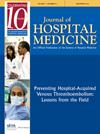临床进展注:苯巴比妥治疗酒精戒断综合征。
IF 2.3
4区 医学
Q1 MEDICINE, GENERAL & INTERNAL
引用次数: 0
摘要
酒精戒断综合征(AWS)是住院患者的常见症状。实践模式随着时间的推移而发展,包括使用苯巴比妥,一种巴比妥类药物,作为苯二氮卓类药物的辅助治疗或作为替代单一疗法。美国成瘾医学协会(ASAM)推荐在某些临床情况下使用苯巴比妥治疗AWS。尽管足以证明苯巴比妥作为苯二氮卓类药物替代品的安全性和有效性,但目前在AWS中使用苯巴比妥的证据基础仍然有限。本文章由计算机程序翻译,如有差异,请以英文原文为准。

Clinical progress note: Phenobarbital in the treatment of alcohol withdrawal syndrome
Alcohol withdrawal syndrome (AWS) is a common condition experienced by hospitalized patients. Practice patterns have evolved over time to include the use of phenobarbital, a barbiturate, as an adjunct to benzodiazepines or as an alternative monotherapy. The American Society of Addiction Medicine (ASAM) has recommended the use of phenobarbital in the management of AWS in certain clinical contexts. The current evidence base for the use of phenobarbital in AWS remains limited, though sufficient to demonstrate safety and efficacy as an alternative to benzodiazepines.
求助全文
通过发布文献求助,成功后即可免费获取论文全文。
去求助
来源期刊

Journal of hospital medicine
医学-医学:内科
CiteScore
4.40
自引率
11.50%
发文量
233
审稿时长
4-8 weeks
期刊介绍:
JHM is a peer-reviewed publication of the Society of Hospital Medicine and is published 12 times per year. JHM publishes manuscripts that address the care of hospitalized adults or children.
Broad areas of interest include (1) Treatments for common inpatient conditions; (2) Approaches to improving perioperative care; (3) Improving care for hospitalized patients with geriatric or pediatric vulnerabilities (such as mobility problems, or those with complex longitudinal care); (4) Evaluation of innovative healthcare delivery or educational models; (5) Approaches to improving the quality, safety, and value of healthcare across the acute- and postacute-continuum of care; and (6) Evaluation of policy and payment changes that affect hospital and postacute care.
 求助内容:
求助内容: 应助结果提醒方式:
应助结果提醒方式:


